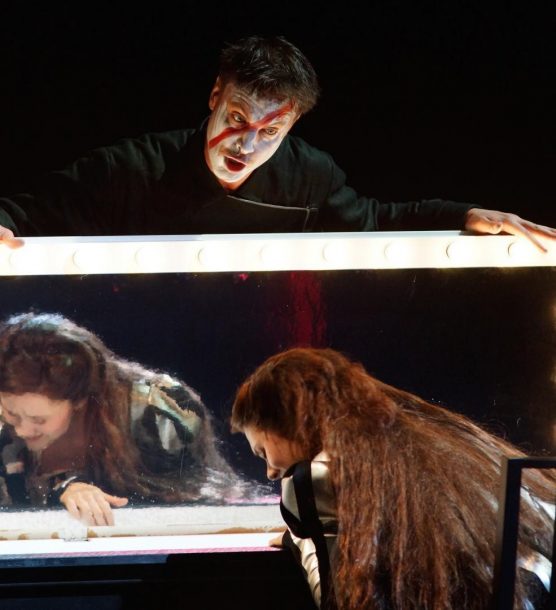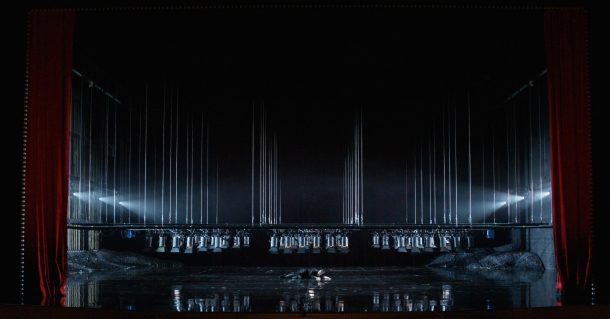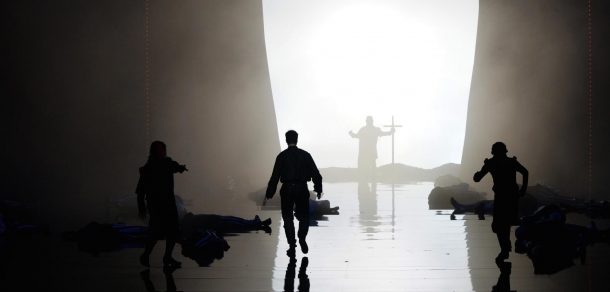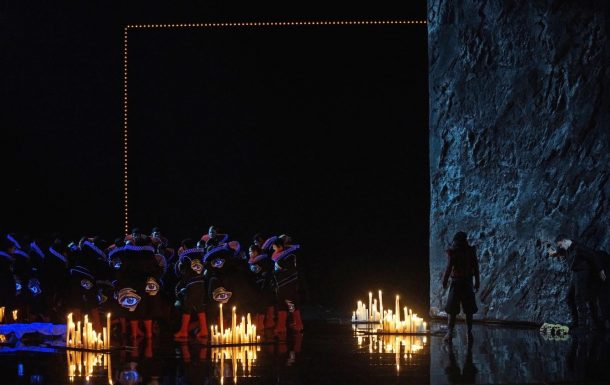The Bregenzer Festspiele, one of several well-appointed summer opera festivals, is situated on the beautiful Lake Constance. It specializes in producing one opera outdoors on a floating stage (Seebühne), thereby creating a stunning backdrop while pleasing the masses with operas that lend themselves to spectacle. This year, the opera was Puccini’s Turandot. Indoors, however, there is a different mission statement at work which consists of rarities, new works, and experiments. Marking the 400th anniversary of Shakespeare’s demise, in 2016, the festival’s Festspielhaus presented the hitherto unknown gem of Franco Faccio’s opera Amleto.
A Forgotten Opera
The Italian music scene in the nineteenth century was doubly entrenched – operas dominated musical productions in a way they did in no other culture – be it that of France, Germany, or England. Only in the twentieth century did Italian composers turn again to chamber music, symphonies, and sonatas. Back then, peras dominated in a way that is hard to imagine now, and the dominating composer of the day was Giuseppe Verdi. After a few early misfires, Verdi broke into the scene in 1842 with Nabucco and continued to maintain a steady stream of successful works all the way to the end of the century, till his last masterpiece called Falstaf, in 1893. Composers who came after him had no way of ignoring his stature. Subsequently, as young men and fellow students at the Milan Conservatory, Franco Faccio (1840-1891), Arrigo Boito (1842-1918) and their friends founded a protest movement called La Scapigliatura (“scapigliare” equates to “to dishevel” in Italian)which aimed to include more symphonic elements in the operatic idiom. They wrote many pamphlets but little music, with the exception of Amleto, a revenge drama. This was audacious in more ways than one. Boito, twenty years old, had never before written a libretto; nor had Faccio ever written an opera. Furthermore, Hamlet was considered supremely unsuitable for the operatic medium. While Italy was acquainted with many of Shakespeare’s works, Hamlet had made its way slowly onto the scene. Giovanni Peruzzini, whose libretto was turned into Hamlet operas in 1848 and 1860, was of the opinion that “the divine creation of Shakespeare is in no way suitable for adaptation in the limited genre of an opera.”[1] The most revolutionary thing of all, however, is the fact that Boito’s text adheres as closely as possible to the Shakespearean original – both in plot points and phraseology. While every other operatic treatment of Hamlet played fast and loose with the material — indeed, tacking on a happy ending was de rigueur — Boito clung closely to the original. His unique talent as a poet and the future heir to the legacy of Verdi is already in evidence in this first work. For instance, when the ghost speaks, Boito utilizes terza rima, the meter Dante used in his Divine Comedy, thereby communicating to an Italian audience that the ghost, coming from beyond, spoke in an older form of speech.[2]
Amleto premiered in 1865 at the Teatro alla Scala to modest success. Both Faccio and Boito then joined the war efforts to unify Italy which afforded Faccio the opportunity to hear music by Beethoven and Wagner. (Boito wrote his own opera, Mefistofele, which premiered in 1868 at La Scala before tanking so completely that it is now one of the many legendary operatic disasters such as the opening nights of Rossini’s Barber of Seville and Bizet’s Carmen.) After the war, Faccio revised the opera, as both Boito and Faccio felt strongly that the Scapigliatura needed to deliver a musical work. In 1871, Amleto was presented at La Scala, but this time it didn’t go too well. The lead tenor Mario Tiberini who played Hamlet had already been sick during rehearsals; but, the administration of La Scala had insisted that the show go on as planned, since they had already invested a lot of money in the production. As a result, Tiberini was declared to be healthy and was made to go on as Hamlet where he, for the most part, was unable to sing. The critics and the audience were unforgiving. Faccio, destroyed, never composed again, refusing any suggestion to remount his opera, and pursued an illustrious career as a conductor. He became the first lead conductor at La Scala and conducted many premieres of Verdi’s operas — the last one being Otello — before dying highly acclaimed in 1891. But by then, his Amleto had vanished.
In 2003, the American conductor Anthony Barrese, then at Sarasota Opera, discovered first, the libretto, and then, the manuscript of Amleto in the Ricordi Archive in Milan. He painstakingly reconstructed the score and, in 2014, as the artistic director of Opera Southwest in Albuquerque, conducted the first performance in 143 years of Faccio’s Amleto. Evenually, Elisabeth Sobotka, artistic director to the Bregenzer Festspiele, who had heard of the opera at the University of Vienna, decided to mount its first European production in the summer of 2016 which, in turn, turned out to be a decision well taken.
Amleto in Bregenz
Once a festival like Bregenz decides to put its resources behind a project, the real mettle of a piece is revealed. Paolo Carignani conducted the Vienna Symphony Orchestra and the Prague Philharmonic Choir with much vigor, thereby highlighting the muscularity of the musical language. Faccio’s score is the archaeopteryx of the nineteenth century – the missing link between the glory of the grand nineteenth-century “Italianità” and the verismo that was to come later. With our hindsight we can hear Mascagni, Leoncavallo, Puccini, and even whiffs of Wagner – all embedded in a solid structure of traditional opera shot with a distinct Verdi feel.
Hamlet’s transformation into opera emphasizes, by the sheer nature of the genre, the story’s more expressive qualities. Hamlet is not an introverted and morose prince but rather openly furious and passionate, while fiercely struggling with the demands of the ghost, his father. Already the opening of the opera contrasts the drunken banquet of Claudius’s coronation with a railing Hamlet in patent discord with the Danish court, whereas the play has Hamlet off to the side brooding until his mother attempts to tease his dissatisfaction out of him. The musical language is fascinating in its mid-century cadence. The score follows all the rules of a nineteenth-century Italian opera with arias, ensembles, a grand Act 2 finale and chorus scenes, along with all the soloists’ parts following this traditional formula. Hamlet, the hero, is the tenor (Pavel Černoch), the villain is a baritone (Claudio Sgura), the jilted lover a lyric soprano (Iulia Maria Dan), the mother a mezzo (Dshamilja Kaiser), and the ghost a meaty basso profundo (Gianluca Buratto). But within this formula too there is variation. Hamlet is not a lyric tenor along the lines of Alfredo in La Traviata; rather, the part requires fortitude and an almost character-tenor edge to portray this quite extroverted Amleto. Pavel Černoch is ideally suited for this part. His tenor is a powerful instrument, clear and expressive while giving us the full range of Amleto’s tormented violence. This Amleto has a brutality about him that is definitely implicit in the Shakespearean text, but is not often seen on a theatrical stage.

Pavel Černoch (Amleto) and Iulia Maria Dan (Ofelia) in Franco Faccio and Arrigo Boito’s Amleto, conducted by Paolo Carignani at the Bregenzer Festspiele, 2016. Photo: Bregenzer Festspiele | Karl Forster.
Iulia Maria Dan’s Ophelia is a light lyric soprano, whose portrayal moves in its innocent emotionality. Claudio Sgura as Claudio could have had more punch; his voice wavers, and he can’t quite keep up with the rest of the excellent cast. The characterization of Gertrude, however, is a departure from the play. Boito gave her an aria and an opportunity to reveal herself directly to the audience, something that Shakespeare did not. After her scene with Amleto, she expresses her anguish over her son’s madness and slowly comes to realize her own complicity in her husband’s murder, resulting in deep remorse on her part. Dshamilja Kaiser is a beautiful Gertrude, warm yet regal, a mother but clearly a woman with lively sexuality, and her voice rings out in this one moment of revelation.
In contrast to straight theatre, opera offers the opportunity of allowing three people to “speak” at once and communicate three very different states of mind and heart. In the music it all comes together and makes sense. Such is the case of the trio in Act 3 which precedes Gertrude’s aria. Amleto confronts his mother in her bedroom with Polonio in hiding. After the prince kills Polonio, the ghost reappears who is seen only by Amleto. What follows is a snapshot of three very different emotional situations – the ghost admonishes Amleto to stay on his course and pursue his revenge for him, the mother deeply worries about her son’s seeming madness, and Amleto debates with the ghost.
The Production
Director Olivier Tambosi is a veteran at staging large works, and with his set designer Frank Philipp Schlößmann and costume designer Gesine Völlm, he created a minimalist framework that enables the characters to tell the story without anY overreaching interpretation. Emphasizing the theatricality of Amleto, the existential questions of “what is real?”, “what is truly happening?”, and “what is the truth?“ are encapsulated in a theatrical metaphor. The Danish court is represented by a frame of vaudeville lights around a red velvet theatre curtain, which are later echoed by mirrors bordered by bulbs on a string of dressing room tables which, in turn, mirror themselves on a reflective black floor.
At the top of the proscenium stage the lighting grid hangs low, thereby framing Hamlet lying on the ground. Once it’s raised, the play begins. It is a powerful metaphor, if not a groundbreaking one. Yet, precisely because of its familiarity, the metaphoric charge is abundantly clear to the audience, and it can certainly be applied to Amleto.

Pavel Černoch (Amleto) below the lighting grid at the opening of Faccio and Boito’s Amleto at the Bregenzer Festspiele, 2016. Photo: Bregenzer Festspiele | Karl Forster.
The mission of Tambosi’s production was to introduce the world to a hitherto unknown work, to show us what we missed and, hopefully, to make us want to see it again. The creative team’s choices therefore favored clarity over originality. For example, when the ghost appears, the back wall opens to reveal him in a white, foggy silhouette, dressed in medieval armor, among heaps of rubble. Clearly, he’s not in a happy place, should we ever have doubted that.

Gianluca Burrato (Ghost) revealed to Pavel Černoch (Amleto) and the guards in Faccio and Boito’s Amleto at the Bregenzer Festspiele, 2016. Photo: Bregenzer Festspiele | Karl Forster.
Within this framework, another major set piece is introduced – an enormous black stone moving through the scenes. In contrast to the gleaming, smooth black floor of the court, the stone is a rough block. Appearing at first slowly from the right, it proceeds to move downstage, almost crushing Amleto and Ofelia and closing off their world. It is indeed the physicalization of a black deed and its symbolic charge, augmented further by the ghost’s fury as he thrusts his sword into it. It also serves as Claudio’s guilt as the stone becomes the wall to his and Gertrude’s shared bedroom, as well as Amleto’s crushing obligation (and curse?) to exact revenge. The stone annihilates the regular life of the characters. It also lends the proceedings a necessary gravitas as we follow their plight, counterbalancing the playful meta-level of the theatrical frame.
Tambosi’s direction leaves room to breathe and yet to connect. The chorus scenes and the play-within-the-play include elements of commedia dell’arte, and the final sword fight between Amleto and Laerte (Paul Schweinester) is virtuosically staged by Ran Arthur Braun on two long tables around which the chorus is seated. The costumes by Gesine Völlm follow the period in form, with the court adhering to the black/white/red scheme of the theatre metaphor but with large eyes printed on various parts of their bodies. Such a creative decision helps to symbolize that guilt cannot be hidden, a bad conscience never sleeps, and nor does the eye in the sky. This is, again, an indication of clarity over subtlety, but the bobbing eyes on the backsides of some individuals give this visual metaphor a humorous slant.

The funeral march from Faccio and Boito’s Amleto at the Bregenzer Festspiele, showing Gesine Völlm’s omnispective court costumes, 2016. Photo: Bregenzer Festspiele | Karl Forster.
Amleto, thankfully sans additional eyes, seems more contemporary in his simple “Hamlet black.” But he covers his face in white makeup, extending even more the metaphor of performance. The players, elements from a world outside the court, are more “natural” and present themselves in earthy tones of green, orange and yellow.
Overall, the result is a unified aesthetic vision that presents the story and music of Amleto transparently to an audience unfamiliar with this long-lost opera.
“To Be or Not to Be?”
Whenever a new or rediscovered work is presented to the public, the question always is – was it worth the effort? And also, will it make it into the repertoire? Most do not, but some indeed have. Boito’s Mefistofele is a case in point. After its inauspicious beginning, it has become almost a staple of the small operatic repertoire. Amleto by Franco Faccio and Arrigo Boito is absolutely worthy of joining these ranks, and the production at the Bregenzer Festspiele has done a beautiful job to launch it.
Let us hope that other opera houses hear the call.
[1] Translation mine; quoted in German in the Bregenzer Festspiele Hamlet program, p. 23. Peruzinni’s Amletos were scored by Antonio Buzzolla and Luigi Moroni, respectively.
[2]Anthony Barrese mentions this fact in his elucidating talk on YouTube for OperaDelaware, https://www.youtube.com/watch?v=sfL22UhQIF8.
Katrin Hilbe is a director of opera and theatre working both in the US and in Europe. Her staging of Richard Strauss’s Salome for New Orleans Opera was awarded “Best Opera Production 2012.” Her select musical theatre/opera credits include Fremd bin ich Eingezogen … (Konstanz), Die Schumann Sonate (Liechtenstein, Basel, and Zürich), Falstaff (Frankfurt), and Pelléas et Mélisande (Würzburg). During 2007-2010, Katrin was the primary Assistant Director for Richard Wagner’s Der Ring des Nibelungen under the direction of Tankred Dorst at the Bayreuth Festival.
European Stages, vol. 7, no. 1 (Fall 2016, Special Issue: Shakespeare in Europe, 2016)
Editorial Board:
Marvin Carlson, Senior Editor, Founder
Krystyna Illakowicz, Co-Editor
Dominika Laster, Co-Editor
Kalina Stefanova, Co-Editor
Editorial Staff:
Cory Tamler, Managing Editor
Mayurakshi Sen, Editorial Assistant
Advisory Board:
Joshua Abrams
Christopher Balme
Maria Delgado
Allen Kuharsky
Bryce Lease
Jennifer Parker-Starbuck
Magda Romańska
Laurence Senelick
Daniele Vianello
Phyllis Zatlin
Table of Contents:
- Some Quadricentennial Shakespeare in Germany by Marvin Carlson
- Tiago Rodrigues’s Antony and Cleopatra by Manuel García Martínez
- Amleto: An Opera Rediscovered by Katrin Hilbe
- Coping With the Greatest for Over One Hundred Years by Alen Biskupović
- The Art of Sharing Shakespeare: Emil Boroghină, a Romanian Sorcerer by Maria Zărnescu
- Shakespeare’s Villains and Modern Politicians in Latvia by Edīte Tišheizere
- A Queen for a King! Tom Lanoye’s Königin Lear at Schauspiel Frankfurt by Katrin Hilbe
- The Tempest: Magical Ballet Where East Meets West by Sepideh Shokri Poori
- “The Ukrainian Play”: Macbeth Ritualized by Vlad Troitskyi by Daria Moskvitina
- Les Kurbas’s Tradition in Ukrainian Shakespeare Productions by Nataliya Torkut
Martin E. Segal Theatre Center:
Frank Hentschker, Executive Director
Marvin Carlson, Director of Publications
Rebecca Sheahan, Managing Director
©2016 by Martin E. Segal Theatre Center
The Graduate Center CUNY Graduate Center
365 Fifth Avenue
New York NY 10016



